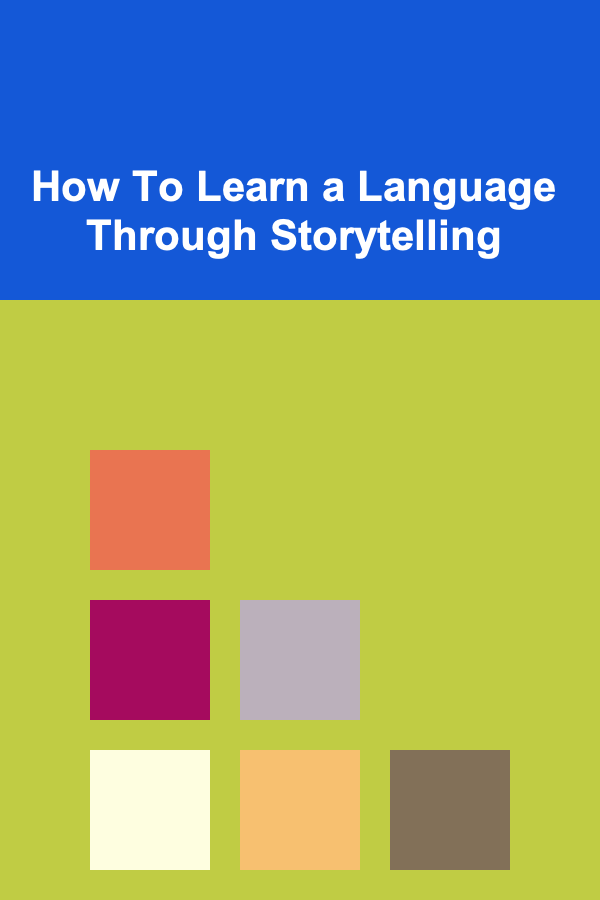
How To Learn a Language Through Storytelling
ebook include PDF & Audio bundle (Micro Guide)
$12.99$9.99
Limited Time Offer! Order within the next:

Learning a new language is often perceived as a daunting task, full of memorization, grammar rules, vocabulary lists, and seemingly endless practice. However, one of the most effective and enjoyable ways to learn a language is through storytelling. Storytelling not only engages the mind and emotions, but it also provides a natural context in which language is used, helping learners internalize vocabulary, grammar, and cultural nuances in a way that is far more memorable than traditional methods.
In this article, we will explore how storytelling can enhance language learning, the various methods of incorporating storytelling into your study routine, and the psychological and cognitive benefits of this approach.
The Power of Storytelling in Language Acquisition
Storytelling has been a part of human culture for millennia. Before written languages, storytelling was the primary method of transmitting knowledge, culture, and history. From ancient oral traditions to modern-day books, movies, and podcasts, stories have always been a tool for learning and connection. In language acquisition, storytelling offers a multitude of benefits:
1. Contextual Learning
One of the main challenges when learning a language is understanding the meaning behind the words. Without context, words and phrases can remain abstract and difficult to grasp. Storytelling naturally provides context for language use. When you hear or read a story, you are exposed to new words and expressions used in real-life situations. This contextualization helps learners understand how language functions in different scenarios, making the new vocabulary and grammar structures easier to remember and apply.
2. Emotional Connection
Humans are wired for stories. Whether it's a fairy tale, a news report, or a personal anecdote, stories capture our attention in a way that abstract information often does not. The emotional engagement involved in storytelling helps solidify the learning process. When learners connect with a story, they are more likely to remember the words and phrases used, as emotional experiences are better encoded in the brain. Storytelling allows you to experience a language emotionally, which deepens your understanding of its nuances.
3. Exposure to Natural Language Patterns
In a traditional classroom setting, learners are often taught isolated words and rules. While this is useful to a certain extent, it doesn't necessarily reflect how the language is used in everyday communication. Stories, however, expose learners to the natural rhythm, flow, and syntax of the language. Dialogue between characters in stories demonstrates how people actually speak, including colloquialisms, slang, and contractions that may not appear in textbooks. This provides learners with a more authentic grasp of how the language is spoken in the real world.
4. Increased Vocabulary Acquisition
When we read or listen to stories, we encounter new words in a meaningful context. Repetition of these words and phrases in different situations reinforces learning. Through storytelling, learners are exposed to a wider range of vocabulary than they would through typical language drills. Furthermore, because the new words are part of a narrative, learners are more likely to remember them and use them correctly.
5. Cultural Understanding
Language and culture are intricately connected. By engaging with stories from different cultures, learners gain insights into the customs, beliefs, and values of the people who speak the language. This cultural understanding enhances the language learning process, as it gives learners a deeper appreciation of the context in which the language is spoken. Understanding the cultural background of a language can also help learners navigate social situations and avoid misunderstandings.
Practical Methods for Learning a Language Through Storytelling
Now that we understand why storytelling is so powerful for language acquisition, let's explore how to incorporate storytelling into your language learning routine. Here are several methods you can use:
1. Reading Stories in the Target Language
Reading is one of the most straightforward ways to learn a language through storytelling. Whether you are reading books, short stories, or even comic books, reading in the target language exposes you to the written form of the language in its natural context. Start with material that is appropriate for your level, such as children's books or graded readers, and gradually progress to more complex texts as you improve.
When reading, try to focus on understanding the overall meaning of the story, rather than getting bogged down by individual words. Use a dictionary sparingly, and try to infer the meaning of unknown words from the surrounding context. This helps you develop your language skills in a more natural way.
2. Listening to Stories
Listening to stories in the target language is another powerful method of learning. Podcasts, audiobooks, and even YouTube videos are excellent sources of spoken storytelling. The advantage of listening over reading is that it helps you become accustomed to the natural rhythm, intonation, and pronunciation of the language.
Start with simpler audio materials, such as children's stories or beginner-level podcasts, and work your way up to more complex content. As you listen, try to transcribe what you hear or summarize the story in your own words. This exercise not only improves your listening comprehension but also reinforces your ability to use the language actively.
3. Storytelling with Visual Aids
For those who are visual learners, combining storytelling with visual aids can be incredibly effective. Watching movies, TV shows, or videos in the target language allows you to follow the storyline while also observing body language, facial expressions, and other visual cues that help you understand the language in context. You can also use picture books or storyboards to follow along as you listen or read.
In addition to passive listening, try retelling the story yourself using your own words. This exercise helps reinforce vocabulary, sentence structures, and narrative flow. You can also experiment with translating stories from your native language into the target language, which encourages active language production.
4. Interactive Storytelling with Language Partners
One of the most immersive ways to learn a language through storytelling is to engage in interactive storytelling with a language partner. This could be a tutor, a language exchange partner, or even a friend who speaks the language. You can take turns telling parts of a story, using the language as naturally as possible. The goal is to keep the story flowing without reverting to your native language.
You can start by narrating simple stories or personal experiences and gradually move to more complex narratives. Asking questions, adding twists to the plot, and creating dialogue between characters all help improve your conversational skills. Interactive storytelling not only helps you practice speaking but also builds confidence in using the language in real-world situations.
5. Writing Your Own Stories
Writing is an excellent way to solidify your understanding of a language, and creating your own stories forces you to apply the vocabulary and grammar you've learned. Start by writing short stories, and gradually build them into more complex narratives. You can challenge yourself by using specific vocabulary words or grammatical structures in each story. Don't worry about making mistakes---writing is a great way to experiment and learn.
You can also try rewriting existing stories in your own words, or retelling them with different endings. This encourages creative thinking while reinforcing language skills. Sharing your stories with a language partner or tutor for feedback can further improve your writing skills.
The Cognitive and Psychological Benefits of Storytelling
In addition to being an effective language learning tool, storytelling also offers significant cognitive and psychological benefits that can enhance the overall learning experience.
1. Enhances Memory Retention
Research has shown that stories are far easier to remember than isolated facts. This is because stories engage multiple areas of the brain, including those associated with emotions, sensory experiences, and memory. When you hear a story, your brain creates connections between new information and prior knowledge, making it easier to recall later. As a result, you are more likely to remember the vocabulary, grammar, and cultural nuances that you encounter in stories.
2. Develops Creativity and Problem-Solving Skills
When you engage in storytelling, especially interactive storytelling, you tap into your creative thinking skills. You need to invent characters, plotlines, and dialogue, all of which require you to think critically and imaginatively. This process strengthens your problem-solving abilities, as you must decide how best to express ideas in the target language.
3. Reduces Anxiety and Builds Confidence
Language learning can often be intimidating, especially when learners are afraid of making mistakes. Storytelling, however, allows learners to focus on the message rather than on their performance. The relaxed and creative nature of storytelling reduces the pressure associated with traditional language learning methods, allowing learners to experiment and make mistakes without fear of judgment. This can build confidence and foster a more positive attitude toward learning.
4. Increases Engagement and Motivation
Storytelling is inherently engaging. Whether you are listening to a captivating podcast, reading an exciting novel, or participating in a storytelling session, stories naturally hold your attention. This increased engagement can lead to better motivation to continue learning, as you will be more invested in the process. Language learning becomes less of a chore and more of an enjoyable and rewarding experience when storytelling is involved.
Conclusion
Learning a language through storytelling is an immersive, engaging, and effective approach that taps into the natural way humans learn. By listening to, reading, and creating stories, language learners can gain contextual knowledge, expand their vocabulary, and improve their speaking and writing skills. The emotional and cognitive benefits of storytelling make it a powerful tool for building fluency and confidence. Whether you are a beginner or an advanced learner, integrating storytelling into your language learning routine can transform your approach to mastering a new language.
So, embrace the power of storytelling---read, listen, create, and immerse yourself in the language. You'll find that the journey becomes not only more enjoyable but also more effective.

How to Create a Cleaning Kit for Quick Touch-Ups
Read More
How to Create an Efficient Laundry Room Storage System
Read More
How to Set Up a Checklist for Book Club Refreshments and Snacks
Read More
How to Understand Craft Beer Cellaring Techniques
Read More
Understanding Craft Beer Fermentation Basics: The Art and Science of Brewing
Read More
10 Tips for Navigating Political Discussions Respectfully
Read MoreOther Products

How to Create a Cleaning Kit for Quick Touch-Ups
Read More
How to Create an Efficient Laundry Room Storage System
Read More
How to Set Up a Checklist for Book Club Refreshments and Snacks
Read More
How to Understand Craft Beer Cellaring Techniques
Read More
Understanding Craft Beer Fermentation Basics: The Art and Science of Brewing
Read More